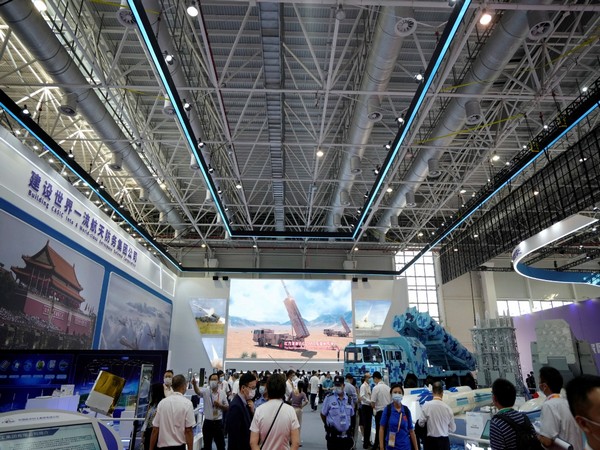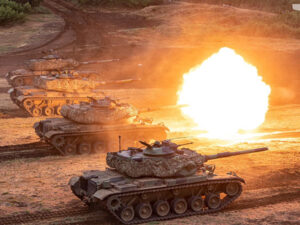
Hong Kong, October 5 (ANI): The China International Aviation and Aerospace Exhibition, typically referred to as the Zhuhai Air Show because of its location near this southern Chinese coastal city, was delayed by eleven months because of the COVID-19 pandemic. Nonetheless, the 13th edition of the enormous event was held last week from 28 September till 3 October.
The Zhuhai Air Show has the full support of the People’s Liberation Army (PLA), central government and Chinese defense industry. While it is described as an air show, in fact air, land and naval equipment are all on grand display. In terms of innovation, variety and scale, China‘s premier defense show is one of the most dynamic in the world.
Indeed, the event gives the world a glimpse of the latest PLA equipment, as well as concepts and designs from Chinese manufacturers. It thus gives foreign analysts a useful glimpse into future directions and priorities of the Chinese military.
In this regard, the latest Zhuhai Air Show did not disappoint, although foreigners were pretty much absent because of China‘s strict quarantine measures and anxiety from media and businesspeople over Beijing’s arbitrary “hostage-taking” practices highlighted by two recently released Canadians.
The biggest news from the 2021 edition of the show were manned aircraft, unmanned aerial vehicles (UAV) and land equipment, so these are examined in turn below.
Beginning with aircraft, the PLA Air Force (PLAAF) showed the J-16D electronic warfare (EW) fighter and J-20A stealth fighter powered by WS10C engines for the very first time. China has never displayed its J-11, J-15 or J-16 fighters at the Zhuhai Air Show before, these being knock-offs of the famous Russian Su-27/Su-30 fighter family.
Perhaps, China previously did not want to flaunt its reverse-engineered fighters in front of Russian delegations.
Nonetheless, the PLAAF statically displayed a twin-seat J-16D. It is China‘s equivalent of the US Navy’s EA-18G Growler, the EW variant of the Super Hornet. The J-16D is presumed to be in service, as the aircraft in Zhuhai bore the construction number “0109”, indicating it is the ninth in the first production batch. However, its operational unit has not been ascertained yet.
According to Senior Colonel Shen Jinke, PLAAF spokesperson, the J-16D “improves the PLAAF’s electronic offensive capabilities, and guarantees its expansion of operational range and strategic transformation”.
The aircraft had four stand-off jamming pods, two on the wingtips and two on under-wing hardpoints. This family of pods – two of which are known to be designated RKZ930-22 and RKZ930-32 – detects, identifies, locates and analyzes radio frequency emissions.
According to Chinese sources, these passive pods are heavier and larger than previous types. Covering the 0.05-20GHz frequency range, a power level of 100kW allegedly gives a range of more than 150km.
The J-16D has a shorter nose radome, indicating a smaller radar is fitted, perhaps an advanced electronically scanned array type. Moving on, two J-20A stealth fighters performed an aerobatic display at Zhuhai.
Notably, they were powered by WS10C Taihang engines, the WS10 being China‘s first high-thrust turbofan. The Taihang is now powering the J-20 instead of originally used Russian-made AL-31 engines. Usefully, the manufacturer revealed specifications for the J-20, listing a length of 21.2m, height of 4.69m and wingspan of 13.01m. Its maximum speed is given as Mach 2.
The J-20 is the PLAAF’s most modern fighter. However, Chinese industry also designed another stealth fighter platform. Unveiled as the FC-31 in 2014’s Zhuhai Air Show, it failed to attract any PLAAF or export attention. However, it is widely believed the design will form the basis of a new PLA Navy (PLAN) fighter for Chinese aircraft carrier operations.
The PLAN currently relies on the J-15, an older-style and heavy fighter copied directly from the Russian Su-33. The navy needs a new more capable aircraft, and there is informed speculation that it will adopt the J-31, a further development of the FC-31.
Sun Cong, chief designer of Chinese jet fighters, tantalizing said at a show press conference that “people should be able to see good news on the next-generation aircraft carrier-based fighter jet” before the end of this year.
In other aircraft news, making its maiden appearance was the PL-15E long-range air-to- air missile. This is an export version of a PLAAF weapon used aboard the J-20, and which could be used against critical assets like enemy airborne early warning and tanker aircraft, for example. The PL-15E’s range was listed as 145km; it is 3.996m long, has a 203mm diameter and 210kg weight. Inevitably, the export version will have a lower range than that used by the PLAAF.
Other PLAAF aircraft to reappear at Airshow China included the J-10 fighter, Y-20 transport aircraft, KJ-500 airborne early warning aircraft and H-6K bomber. The JL-10 trainer jet was a debutant, while the under-development AG600 amphibian performed in a flight display.
Perhaps the greatest excitement at the show should be reserved for China‘s vigorous UAV sector, among the world’s most active. Some highlights are described below. Firstly, the CH-6 medium-altitude long-endurance unmanned combat aerial vehicle (UCAV) emanates from the China Aerospace Science and Technology Corporation (CASC).
This entity has sold UAVs to 10+ export customers so far, with its most popular CH-4 having achieved more than 4,000 flights by foreign users to date. The CH-6 is a top-end UCAV featuring a chined fuselage, T-tail and tapered wings that end in split winglets, a novel configuration for CASC.
Shi Wen, chief designer of CH-series UAVs, explained: “The CH-6 is capable of performing a wide range of tasks, including high-altitude reconnaissance and airstrike, anti-submarine and sea patrol operations, long-range early warning and close-in firepower support. In future combat scenarios, the drone can engage in action in groups and can also cooperate with piloted aircraft or other unmanned hardware to conduct various types of operations.”
The CH-6’s development reportedly started in June 2019, with a prototype completed in July 2021. Its first flight is slated for October 2022. In terms of dimensions, its maximum take-off weight is 7.8 tonnes, and it measures 15m long, 5m high and has a 20.5m wingspan. Two turbofans provide a top speed of 800km/h, or cruise speed of 500-700km/h. Its ceiling is 12km, and maximum range is 12,000km or 4,500km, depending on whether it is an unarmed UAV or an armed UCAV.
The CH-6 can carry a 300kg payload of sensors (reconnaissance type) or 2 tonnes of sensors and munitions (attack type). The two versions have a maximum endurance of 20 hours or 8 hours respectively.
Secondly, on display for the first time was a WZ-7 Soaring Dragon of the PLAAF. It is China‘s primary high-altitude long-endurance UAV for strategic reconnaissance, the equivalent of the American RQ-4 Global Hawk. The most distinctive thing about the WZ-7 is its joined tandem wings, said to give an increased lift-to-drag ratio. It is 14m long, 3.9m high and has a 22.8m wingspan.
The WZ-7 is in service with the PLAAF, and so far seven examples have been spotted at Shigatse Air Base in Tibet, Lingshui Air Base on Hainan Island, and at Yishuntun Air Base near North Korea in the past few years.
The WZ-7 is routinely used for border reconnaissance missions and for maritime surveillance, and it can presumably designate targets for Chinese cruise missiles and anti-ship ballistic missiles.
Thirdly, also making a maiden appearance at Zhuhai was the WZ-8 high-speed and high- altitude reconnaissance UAV. This mysterious aircraft debuted at a Beijing military parade on 1 October 2019, and two liquid-fueled rocket engines offer a claimed supersonic speed of Mach 3.
Two lugs on the WZ-7’s back suggest it can be carried by H-6N strategic bombers; release from the air greatly multiplies the WZ-7’s range. As part of an early-warning network, the WZ-8 can perform close reconnaissance and aid precision strikes for weapons like the DF-26 ballistic missile.
Fourthly, as well as the CH-6, CASC showed off its Feihong (FH) series of UAVs. The most interesting family member is the FH-97, a medium- and long-range UAV with stealthy design similar to the American XQ-58A Valkyrie. If it enters production, the FH-97 could be intended as a Chinese “loyal wingman”, a lower-cost unmanned platform that can go into dangerous situations instead of or alongside regular Chinese fighters.
The FH-97 mock-up at Zhuhai had a stealthy trapezoidal fuselage, sharply swept main wings, a V-shaped tail and a dorsal air intake. It had an internal weapons bay and nose-mounted electro-optical sensor. The FH-97 is powered by two jet engines, and it appears roughly similar in size to the XQ-58A. Whether the FH-97 is aimed at the PLAAF or export markets is unclear, nor is the status of its development known.
Fifthly, a mock-up of the GJ-11 Sharp Sword armed reconnaissance UAV was also exhibited in Zhuhai; this too had been unveiled in the aforementioned Beijing 2019 parade. This flying-wing design reminiscent of the American X-47B has two internal weapon bays, each able to hold four weapons.
Turning to land-based equipment, Chinese firms displayed new radars, air defense systems and armored vehicles.
Displayed on the tarmac were radars from the China Electronics Technology Group Corporation’s (CETC) 14th Institute. These included the Lingdong family: the YLC-8E UHF-band anti-stealth air defense radar; trailer-mounted SLC-7 L-band multifunctional air defense radar; SLC-12 S band alert radar; and YLC-12 C-band medium- and low-altitude multifunctional radar. These radars can network with each other.
The YLC-8E, mounted on a 12×12 truck chassis, is the flagship. This mobile stealth-target detection radar detects medium- and long-range targets. Its antenna is the size of two badminton courts, and the array can unfurl and stow away in ‘tens of seconds’. Cao Jian, deputy director of the 14th Institute, said this multiband anti-stealth radar was at ‘an advanced level in the world,’ and that it can change its working wavelengths to spot stealthier targets.
CETC also showed the Type 610 long-range radar, a type that had appeared in the 2019 parade.
As for air defense systems, new was CASC’s LY-70 mounted on a 6×6 truck. This featured two sets of four missile canisters, with three shorter-range FB-10A short-range missiles mounted above each set. Interestingly, company literature showed an alternative launcher configuration of three sets of four canisters plus three FB-10As.
The LY-70 missile’s range is believed to be up to 40km, suggesting it is a variant of the HQ-6A/LY-60 with added booster. Also on show was an HQ-9BE air defense system, with the “E” indicating it is destined for export. It has a 260km maximum range. Furthermore, new from the China Aerospace Science and Industry Corporation (CASIC) was a reconfigured FK-1000 short-/medium-range air defense system based on an 8×8 truck chassis. The FK-1000 missiles (two sets of six canisters) are combined with two Gatling guns and surveillance radar.
A new armored vehicle from state-owned Norinco was the new-generation VN22, a 6×6 vehicle fitted with UW5 unmanned turret featuring a 30mm cannon and pop-up twin anti-tank missile launcher. Norinco said the VN22 can perform troop transport, patrol, reconnaissance, counterterrorism and peacekeeping missions. The PLA currently relies on the Type 92/92B 6×6 family, and it is unclear if it will be adopting the VN22.
Norinco showed different unmanned ground vehicles (UGV) too. The largest was the tracked VU-T10 combat system. Bearing an overhead weapon station with automatic cannon, it has a combat weight of 11 tonnes. Smaller was the 1.8-tonne tracked VU-T2 with a 12.7mm machine gun and two anti-tank weapons.
The PLA employs Mengshi 4×4 and 6×6 tactical vehicles in a plethora of variants. The newest type to be developed is a Mengshi 4×4 fitted with a 30mm automatic cannon in a rotating rooftop remote-controlled weapon station.
Also exhibited was a new counter-UAV laser system. Mounted on a 6×6 truck, it could well be a development of the LW-30 30kW laser revealed in 2018. China has a very healthy defense industry, with research, development and production occurring at an incredible pace. With new products available for both the domestic market and export, China shows no sign of slowing down its prioritization of military technology. (ANI)


















